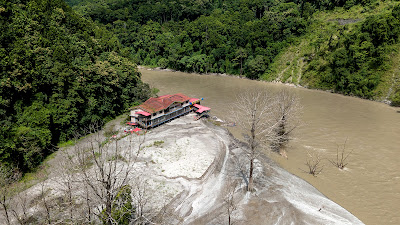We, at SaveTheHills have long realized the importance of real-time weather inputs especially in the Himalayas where weather can change quickly and with devastating consequences.
In this regard, 'Hazard Alerts', our WhatsApp based social media group in this region, does precisely that - disburse verified information on weather and updates on forecast heavy rain, hazards such as landslides, road closures to the community in the quickest time and I am extremely happy to state that all three WhatsApp groups (Hazard Alerts 1,2, 3) and our other social media handles in Instagram, FB and so on, have today emerged as disciplined, powerful community driven platforms, which share such information and help each other using reports from individual members, satellite images of clouding, lightning app reports, social media posts and so on.
STH has also encouraged and helped in establishing a network of online AWS in this region so that real-time information from these stations is available to the community as well as disaster management people of this region:
I was keeping a track of Hurricane 'Milton' recently, and was able to monitor the rainfall data of several places around Tampa , Florida from my home in the Himalayan foothills as the storm wreaked havoc there. I accessed the weather in real-time on the Weatherlink app for Davis automatic weather stations in the area.
It is amazing to see how powerful technology is these days and I was particularly impressed to see the density of DAVIS AWS which are available at the Tampa bay area, probably because this area is prone to hurricanes and heavy rain/storm surges.
Real-time data on rainfall intensity and high-velocity winds can play a crucial role in warning communities about potential landslides and flooding. This allows for timely evacuations, prioritization of relief efforts, and ultimately, saving lives. It also allows preservation of valuable weather data of the region.
To maximize early warning systems, information from Automatic Weather Stations (AWS), satellite imagery, lightning reports from apps like Weatherbug and Damini, and even social media should be fully utilized. This is especially critical as climate change and warmer oceans are causing extreme weather events to become more intense, unpredictable, and accompanied by increased rainfall.
While I specifically mention DAVIS AWS, as we’ve successfully used this equipment for 6-7 years, there are undoubtedly many other reliable brands. The key requirement is that weather data must be available online with frequent updates.
For instance, the India Meteorological Department (IMD) has an AWS site that I found helpful during the 2024 monsoon season. However, the site’s updates are not as frequent, and parameters like rainfall intensity are missing. To address these gaps, private networks, such as the one in our region, can provide essential supplementary data.
STH strongly recommends building up on what is already available so as to make our early warning systems more robust and effective.
Praful Rao
SaveTheHills
savethehills@gmail.com
9475033744





















































